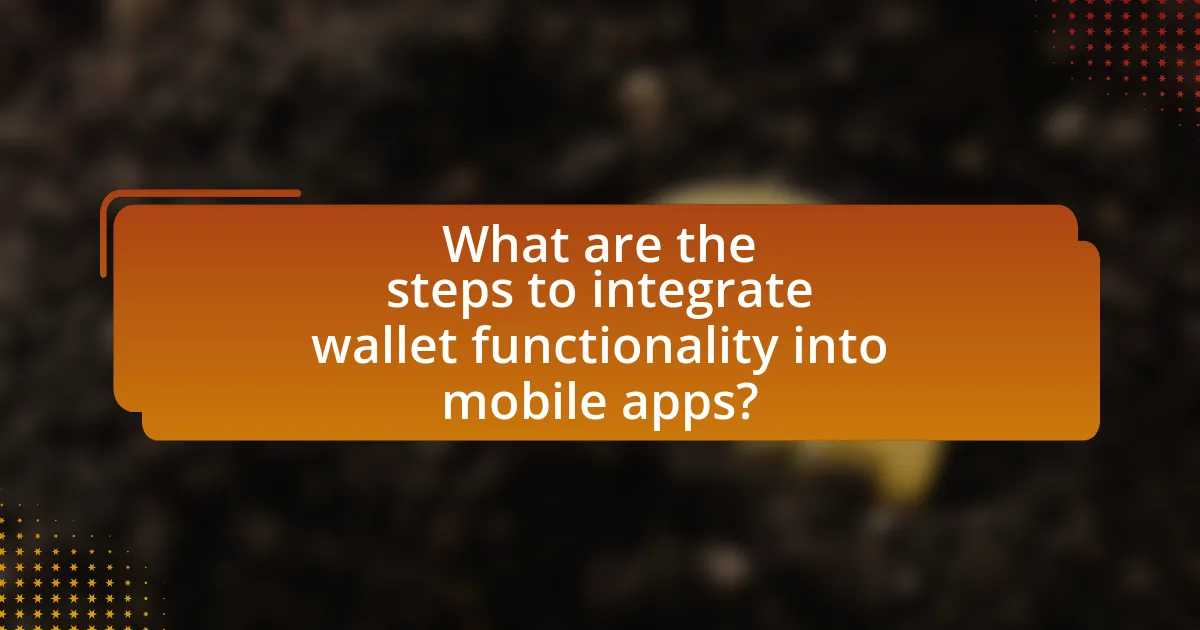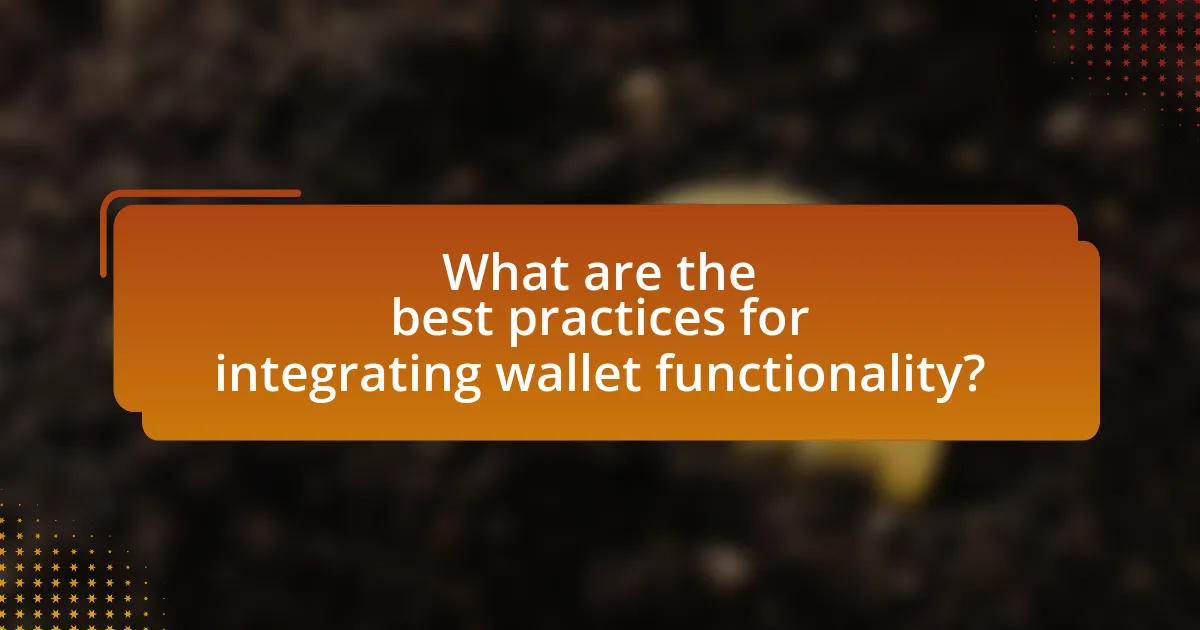Wallet functionality in mobile apps enables users to securely store, manage, and transact with digital currencies and payment methods within a single application. This article outlines the importance of integrating wallet functionality, highlighting its key features such as secure payment information storage, transaction history tracking, and support for multiple payment methods. It also discusses the advantages for app developers, including enhanced user engagement and retention, as well as best practices for integration, security measures, and user experience considerations. Additionally, the article explores future trends and innovations in wallet functionality, emphasizing the growing demand for seamless and secure digital payment solutions.

What is Wallet Functionality in Mobile Apps?
Wallet functionality in mobile apps refers to the capability that allows users to store, manage, and transact with digital currencies, payment methods, and loyalty cards within a single application. This functionality typically includes features such as secure storage of payment information, transaction history, and integration with various payment gateways, enabling seamless purchases and transfers. According to a report by Statista, the global mobile wallet market is projected to reach over $7 trillion by 2024, highlighting the increasing adoption and importance of this feature in enhancing user convenience and security in financial transactions.
How does wallet functionality enhance mobile app experiences?
Wallet functionality enhances mobile app experiences by providing users with a seamless and secure method for transactions and managing digital assets. This integration allows for quick payments, reducing friction during the checkout process, which can lead to higher conversion rates. According to a study by Statista, mobile wallet users are projected to reach 1.31 billion by 2023, indicating a growing preference for this payment method. Additionally, wallet features often include loyalty programs and personalized offers, further engaging users and encouraging repeat usage. This combination of convenience, security, and added value solidifies wallet functionality as a critical component in enhancing mobile app experiences.
What are the key features of wallet functionality?
The key features of wallet functionality include secure storage of payment information, transaction history tracking, and integration with various payment methods. Secure storage ensures that sensitive data, such as credit card numbers and personal identification, is encrypted and protected against unauthorized access. Transaction history tracking allows users to view past purchases, providing insights into spending habits and facilitating budgeting. Integration with various payment methods, including credit cards, debit cards, and digital currencies, enhances user convenience by allowing multiple payment options within a single platform. These features collectively improve user experience and security in mobile transactions.
How does wallet functionality differ from traditional payment methods?
Wallet functionality differs from traditional payment methods primarily by enabling digital transactions through mobile devices, which enhances convenience and speed. Unlike traditional methods that often require physical cards or cash, digital wallets store payment information securely and allow users to make transactions with a simple tap or scan. For instance, a study by Statista in 2021 indicated that mobile wallet usage was projected to reach 1.31 billion users globally, highlighting the growing preference for this method over cash and card payments. Additionally, digital wallets often incorporate features like loyalty programs and transaction tracking, which are not typically available with traditional payment methods, further illustrating their distinct advantages.
Why is integrating wallet functionality important for mobile apps?
Integrating wallet functionality is important for mobile apps because it enhances user convenience and streamlines transactions. Wallet features allow users to store payment information securely, facilitating quick and easy purchases without the need for manual entry of card details. According to a report by Statista, mobile wallet users are expected to reach 1.31 billion globally by 2023, indicating a significant shift towards digital payment methods. This integration not only improves user experience but also increases customer retention and engagement, as users prefer apps that offer seamless payment solutions.
What advantages does wallet integration provide to app developers?
Wallet integration provides app developers with enhanced user engagement and streamlined payment processes. By incorporating wallet functionality, developers can offer users a convenient and secure method for transactions, which can lead to increased customer satisfaction and retention. Furthermore, wallet integration often supports various payment methods, allowing developers to cater to a broader audience. According to a study by Statista, mobile wallet usage is projected to reach 1.31 billion users by 2023, highlighting the growing demand for such features. This trend indicates that developers who integrate wallet functionality can capitalize on this expanding market, ultimately driving revenue growth and improving user experience.
How does wallet functionality improve user engagement and retention?
Wallet functionality enhances user engagement and retention by providing a seamless and convenient payment experience. Users are more likely to engage with an app that allows for quick transactions, reducing friction during the purchasing process. According to a study by PayPal, 54% of consumers are more likely to complete a purchase when offered a digital wallet option. Additionally, wallet features such as loyalty rewards and personalized offers encourage repeat usage, as users feel incentivized to return to the app for benefits. This integration of wallet functionality not only streamlines transactions but also fosters a sense of loyalty, ultimately leading to higher retention rates.

What are the steps to integrate wallet functionality into mobile apps?
To integrate wallet functionality into mobile apps, follow these steps: first, choose a suitable payment gateway or wallet service provider, such as PayPal, Stripe, or Square, which offer APIs for integration. Next, set up a developer account with the chosen provider to access their SDKs and documentation. Then, implement the SDK into your mobile app, ensuring to configure the necessary permissions and settings for secure transactions. After that, create user interfaces for wallet features, including adding funds, making payments, and viewing transaction history. Finally, conduct thorough testing to ensure the wallet functionality works seamlessly and securely before launching the app. These steps are essential for providing a reliable and user-friendly wallet experience in mobile applications.
How do you choose the right wallet solution for your app?
To choose the right wallet solution for your app, assess your app’s specific needs, including transaction types, user demographics, and security requirements. Evaluating these factors helps identify wallet solutions that align with your app’s functionality and user experience goals. For instance, if your app targets a global audience, consider a wallet that supports multiple currencies and payment methods. Additionally, prioritize security features such as encryption and fraud detection, as these are critical for user trust. Researching user reviews and case studies of similar apps can provide insights into the effectiveness and reliability of various wallet solutions, ensuring you select one that meets both your technical and user-centric criteria.
What factors should be considered when selecting a wallet provider?
When selecting a wallet provider, security features are the most critical factor to consider. A reputable wallet provider should implement strong encryption, two-factor authentication, and regular security audits to protect user data and funds. Additionally, the provider’s compliance with regulatory standards, such as PCI DSS for payment processing, ensures that they adhere to industry best practices. User experience is also essential; the wallet should have an intuitive interface and provide seamless integration with mobile apps. Furthermore, transaction fees and supported currencies can significantly impact user satisfaction, so evaluating these aspects is necessary. Lastly, customer support availability can influence the overall experience, as prompt assistance is vital for resolving issues.
How do different wallet solutions compare in terms of features and fees?
Different wallet solutions vary significantly in features and fees, impacting user choice. For instance, hardware wallets like Ledger and Trezor offer high security with features such as offline storage and multi-currency support, but they typically charge a one-time fee ranging from $50 to $200. In contrast, software wallets like Coinbase and Trust Wallet provide user-friendly interfaces and easy access to cryptocurrencies, often with lower fees, such as transaction fees around 1% to 3% per transaction. Additionally, some wallets, like PayPal, offer integrated payment solutions but may impose higher fees for currency conversion and withdrawal. Overall, the choice of wallet solution depends on the balance between desired features, such as security and usability, and the associated fees.
What are the technical requirements for integration?
The technical requirements for integration of wallet functionality into mobile apps include a secure API for communication, compliance with payment industry standards such as PCI DSS, and support for various payment methods like credit cards and digital wallets. Additionally, developers must implement encryption protocols to protect sensitive data and ensure compatibility with mobile operating systems like iOS and Android. These requirements are essential to facilitate secure transactions and maintain user trust in the application.
What programming languages and frameworks are commonly used?
Commonly used programming languages for integrating wallet functionality into mobile apps include Java, Swift, and Kotlin. Java is widely utilized for Android development, while Swift is the primary language for iOS applications. Kotlin, being fully interoperable with Java, is increasingly favored for Android development due to its modern features and concise syntax.
Frameworks that support wallet integration include React Native, Flutter, and Xamarin. React Native allows developers to build cross-platform apps using JavaScript, while Flutter, developed by Google, enables the creation of natively compiled applications for mobile from a single codebase using Dart. Xamarin, a Microsoft framework, allows for cross-platform mobile app development using C#.
These languages and frameworks are chosen for their robust ecosystems, community support, and compatibility with various payment APIs, making them effective for implementing wallet functionalities in mobile applications.
How do APIs facilitate wallet integration?
APIs facilitate wallet integration by providing standardized protocols that enable communication between mobile applications and wallet services. These APIs allow developers to access wallet functionalities such as payment processing, transaction history retrieval, and user authentication seamlessly. For instance, payment APIs like Stripe or PayPal offer specific endpoints that developers can use to initiate transactions or manage user accounts, ensuring that the integration process is efficient and secure. This standardization reduces the complexity of integrating various wallet services, allowing for quicker deployment and improved user experience.

What are the best practices for integrating wallet functionality?
The best practices for integrating wallet functionality include ensuring robust security measures, providing a seamless user experience, and supporting multiple payment methods. Security is paramount; implementing encryption, two-factor authentication, and compliance with standards like PCI DSS protects user data. A seamless user experience involves intuitive design, quick transaction processes, and clear instructions, which enhance user satisfaction and retention. Supporting multiple payment methods, including credit cards, digital currencies, and loyalty programs, caters to diverse user preferences and increases adoption rates. These practices are validated by industry standards and user feedback, demonstrating their effectiveness in enhancing wallet functionality in mobile apps.
How can you ensure a secure wallet integration?
To ensure a secure wallet integration, implement strong encryption protocols for data transmission and storage. Utilizing industry-standard encryption methods, such as AES-256, protects sensitive information from unauthorized access. Additionally, conducting regular security audits and vulnerability assessments helps identify and mitigate potential risks. According to the 2021 Verizon Data Breach Investigations Report, 85% of breaches involve a human element, emphasizing the importance of user education on security practices. Furthermore, integrating multi-factor authentication (MFA) adds an extra layer of security, significantly reducing the likelihood of unauthorized access.
What security measures should be implemented during integration?
To ensure secure integration of wallet functionality into mobile apps, implement measures such as data encryption, secure API access, and user authentication. Data encryption protects sensitive information during transmission and storage, while secure API access prevents unauthorized interactions with the wallet service. User authentication, including multi-factor authentication, adds an additional layer of security by verifying user identity before granting access to wallet features. According to the National Institute of Standards and Technology (NIST), encryption and strong authentication are critical components of secure application design, emphasizing their importance in safeguarding financial transactions and user data.
How do you handle user data privacy in wallet functionality?
User data privacy in wallet functionality is handled through robust encryption, secure storage, and compliance with data protection regulations. Encryption ensures that sensitive information, such as payment details and personal identifiers, is transformed into a secure format that is unreadable without the appropriate decryption key. Secure storage methods, such as using hardware security modules or secure enclaves, protect user data from unauthorized access. Compliance with regulations like GDPR and CCPA mandates that user consent is obtained for data collection and processing, and users are informed about their rights regarding their data. These measures collectively safeguard user privacy and build trust in wallet functionality.
What user experience considerations should be made?
User experience considerations for integrating wallet functionality into mobile apps include simplicity, security, and accessibility. Simplicity ensures that users can navigate the wallet features intuitively, reducing the learning curve and enhancing user satisfaction. Security is paramount, as users must trust that their financial information is protected; implementing robust encryption and authentication measures is essential. Accessibility involves designing the wallet interface to accommodate users with varying abilities, ensuring that all users can effectively utilize the features. Research indicates that 70% of users abandon apps due to poor usability, highlighting the importance of these considerations in retaining users and fostering engagement.
How can you design an intuitive wallet interface?
To design an intuitive wallet interface, prioritize user experience by implementing a clean layout, clear navigation, and accessible features. A clean layout minimizes clutter, allowing users to focus on essential functions like balance viewing, transaction history, and payment options. Clear navigation ensures that users can easily find what they need, which can be achieved through recognizable icons and straightforward labels. Accessible features, such as quick access buttons for common actions like sending money or checking balances, enhance usability. Research indicates that 70% of users prefer interfaces that are simple and easy to navigate, reinforcing the importance of these design principles in creating an effective wallet interface.
What feedback mechanisms can enhance user satisfaction?
User satisfaction can be enhanced through several feedback mechanisms, including surveys, user testing, and real-time feedback tools. Surveys allow users to express their opinions and experiences, providing valuable insights into their needs and preferences. User testing involves observing users as they interact with the app, revealing usability issues and areas for improvement. Real-time feedback tools, such as in-app messaging or feedback buttons, enable users to report issues or suggest enhancements immediately, fostering a responsive development process. These mechanisms collectively contribute to a better user experience by addressing concerns and adapting to user needs effectively.
What are common challenges faced during integration?
Common challenges faced during integration of wallet functionality into mobile apps include compatibility issues, security concerns, and user experience optimization. Compatibility issues arise when the wallet system does not seamlessly integrate with existing app architecture or various operating systems, leading to functionality disruptions. Security concerns are paramount, as integrating payment systems requires stringent measures to protect sensitive user data from breaches; for instance, a study by Verizon in 2020 highlighted that 80% of data breaches involved weak or stolen passwords. User experience optimization is also critical, as a complex integration can lead to confusion or frustration among users, ultimately affecting adoption rates.
How can you troubleshoot integration issues effectively?
To troubleshoot integration issues effectively, first, identify the specific error messages or symptoms occurring during the integration process. This can involve reviewing logs, monitoring network traffic, and checking API responses to pinpoint where the failure occurs. Once the issue is identified, validate the integration points by ensuring that all endpoints are correctly configured and that the data formats match the expected specifications. Additionally, testing with various scenarios, including edge cases, can help uncover hidden issues.
For example, a study by the International Journal of Software Engineering and Its Applications highlights that systematic logging and monitoring can reduce integration errors by up to 30%. By following these steps, developers can systematically address and resolve integration issues, ensuring a smoother implementation of wallet functionality in mobile apps.
What are the most frequent pitfalls to avoid in wallet integration?
The most frequent pitfalls to avoid in wallet integration include inadequate security measures, poor user experience, and lack of compliance with regulations. Inadequate security measures can lead to data breaches, as evidenced by the 2020 Verizon Data Breach Investigations Report, which highlighted that 28% of breaches involved stolen credentials. Poor user experience can result in low adoption rates; a study by the Nielsen Norman Group found that 70% of users abandon apps due to usability issues. Lastly, failing to comply with regulations, such as PCI DSS for payment processing, can result in legal penalties and loss of customer trust, as noted by the 2021 Payment Card Industry Compliance Report, which indicated that 60% of organizations faced compliance challenges.
What are the future trends in wallet functionality for mobile apps?
Future trends in wallet functionality for mobile apps include enhanced security features, integration of cryptocurrencies, and the incorporation of AI-driven personalized experiences. Enhanced security features, such as biometric authentication and advanced encryption, are becoming essential as users prioritize safety in digital transactions. The integration of cryptocurrencies is gaining traction, with mobile wallets increasingly supporting various digital currencies, reflecting the growing acceptance of blockchain technology. Additionally, AI-driven personalized experiences are emerging, allowing wallets to offer tailored recommendations and promotions based on user behavior, thereby improving user engagement and satisfaction. These trends are supported by industry reports indicating a significant rise in mobile wallet adoption and usage, projected to reach over 1.3 billion users globally by 2024, according to Statista.
How is technology evolving in the realm of mobile wallets?
Technology is evolving in the realm of mobile wallets through advancements in security, user experience, and integration with other financial services. Enhanced security measures, such as biometric authentication and tokenization, are being implemented to protect user data and transactions. For instance, a report by Juniper Research indicates that the use of biometric authentication in mobile payments is expected to grow significantly, with projections showing that over 1.5 billion users will utilize biometric methods by 2025. Additionally, mobile wallets are increasingly offering seamless integration with loyalty programs, cryptocurrencies, and peer-to-peer payment systems, enhancing their functionality and user appeal. This evolution is driven by consumer demand for convenience and security in digital transactions, as evidenced by the rapid growth of mobile wallet adoption, which reached over 1 billion users globally in 2022 according to Statista.
What innovations can we expect in wallet functionality?
Innovations in wallet functionality will likely include enhanced biometric security features, integration with decentralized finance (DeFi) platforms, and improved user interfaces for seamless transactions. Biometric security, such as facial recognition and fingerprint scanning, is becoming standard to protect user data and prevent fraud. Integration with DeFi platforms allows users to access a broader range of financial services directly from their wallets, facilitating activities like lending and earning interest on crypto assets. Additionally, advancements in user interface design will focus on simplifying navigation and transaction processes, making it easier for users to manage their finances efficiently. These trends are supported by the increasing adoption of mobile payment solutions and the growing demand for secure, user-friendly financial applications.
What tips can help ensure successful wallet integration?
To ensure successful wallet integration, prioritize user experience by implementing a seamless onboarding process. A smooth onboarding experience encourages users to adopt the wallet functionality, as evidenced by studies showing that 70% of users abandon apps due to complicated registration processes. Additionally, ensure robust security measures, such as encryption and two-factor authentication, to build user trust; a report by Cybersecurity Ventures indicates that 60% of consumers are concerned about security when using digital wallets. Finally, provide clear and accessible customer support to address user inquiries promptly, which can enhance user satisfaction and retention.


